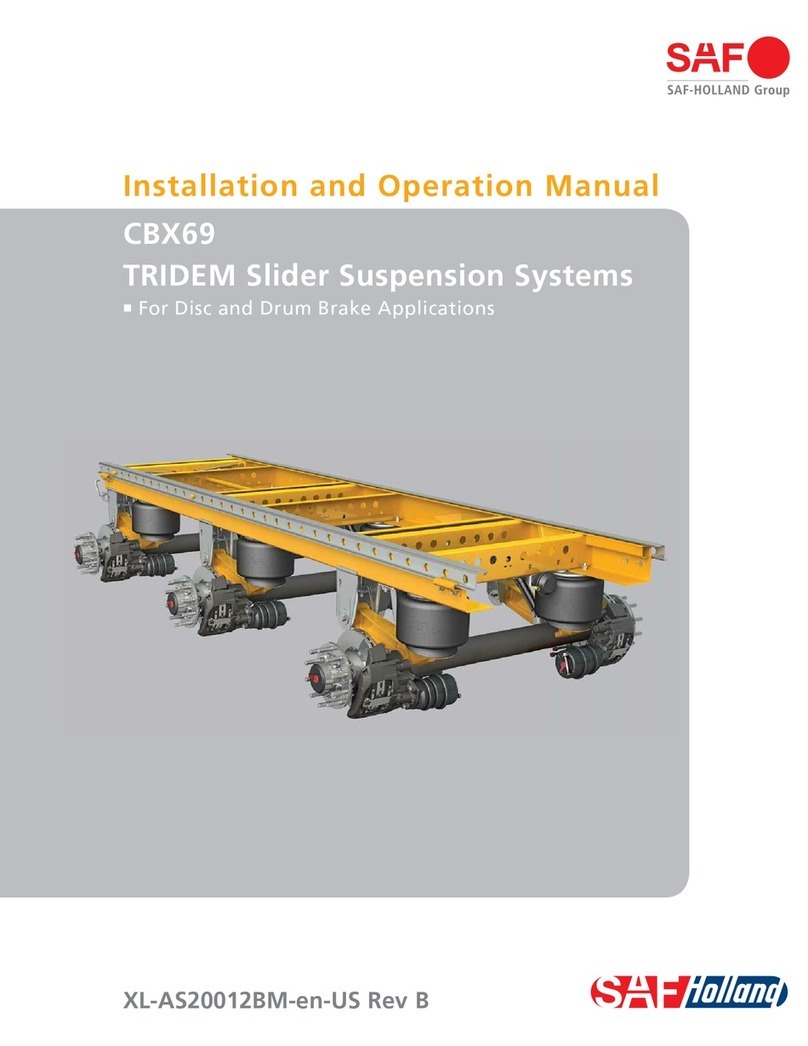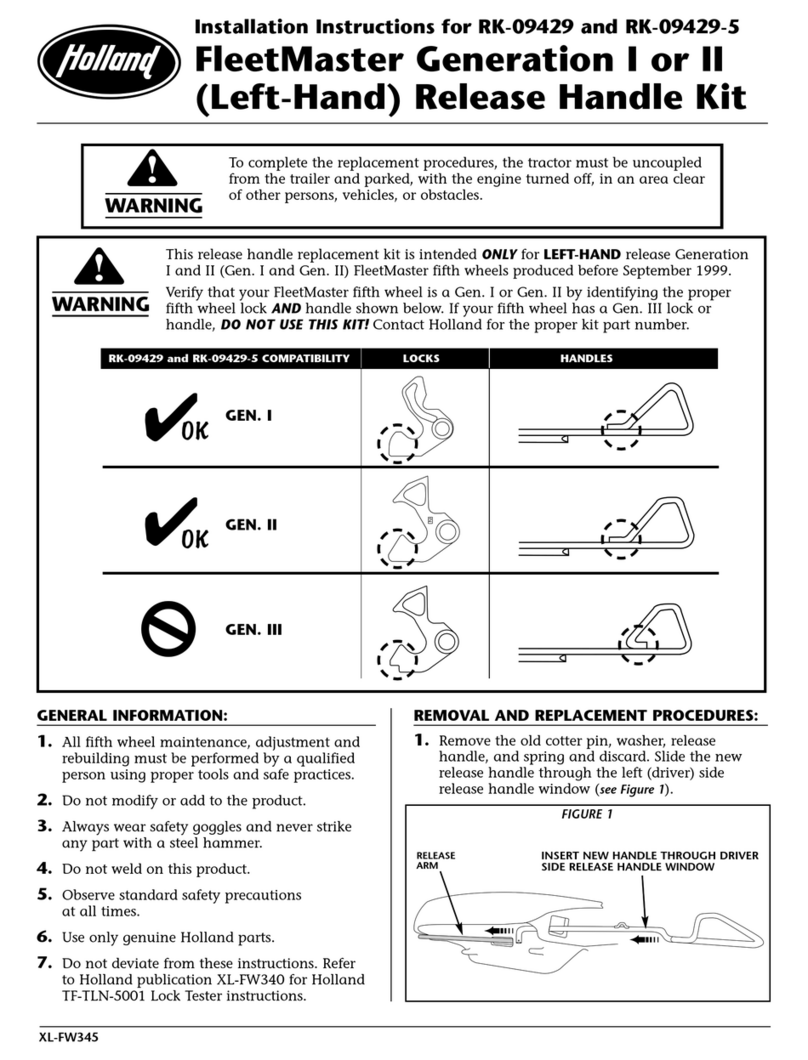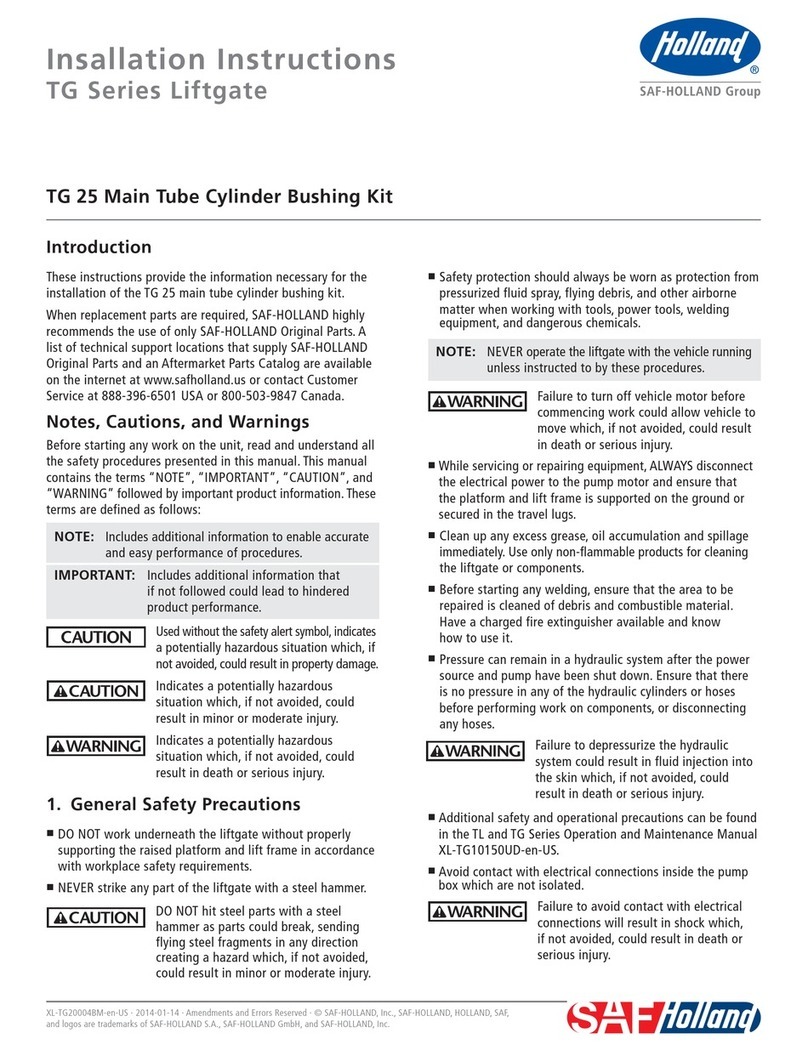
XL-AS20053BM-en-US · 2016-09-27 · Amendments and Errors Reserved · © SAF-HOLLAND, Inc., SAF-HOLLAND, HOLLAND, SAF,
and logos are trademarks of SAF-HOLLAND S.A., SAF-HOLLAND GmbH, and SAF-HOLLAND, Inc.
General Safety Instructions
4
Operational and Road Safety Instructions
Before operating vehicle, ensure that the maximum permissible
axle load is NOT exceeded and that the load is distributed
equally and uniformly.
Make sure that the brakes are NOT overheated from
continuous operation.
Failure to minimize the use of brakes during
overheating conditions could result in
deterioration of brake efficiency which,
if not avoided, could result in death or
serious injury.
The parking brake MUST NOT be immediately applied when
the brakes are overheated.
If the parking brake is immediately applied
to the brakes when overheated, the brake
drums or discs could be damaged by different
stress fields during cooling.
Observe the operating recommendation of the trailer
manufacturer for off-road operation of the installed axles.
IMPORTANT: The definition of OFF-ROAD means driving
on non-asphalt/non-concrete routes, e.g.
gravel roads, agricultural and forestry tracks,
on construction sites and in gravel pits.
IMPORTANT: Off-road operation of axles beyond
the approved application design could
result in damage and impair suspension
system performance.
Follow the recommended routine maintenance and inspections
described in this manual. These procedures are designed so
that optimum performance and operational safety are achieved.
In the event of suspension air pressure loss, quickly reduce
speed as safely as possible and remove the vehicle from
traffic. If unable to remove vehicle from traffic, follow DOT
safety requirements regarding emergency situations.
Contact a qualified towing and/or service company to assist
in repairing the vehicle or to move it to a qualified repair facility.
DO NOT operate the vehicle in the absence of suspension
air pressure; however in the event of an air system failure
while in service, an internal rubber bumper built into the
air spring will make it possible to temporarily operate the
vehicle at reduced speed determined by road conditions.
Operating the vehicle without proper air
pressure can cause tire failure, fire, or loss
of vehicle control which, if not avoided,
could result in death or serious injury.
1. Safety Instructions
General and Servicing Safety Instructions
Read and observe all Warning and Caution hazard alert
messages. The alerts provide information that can help prevent
serious personal injury, damage to components, or both.
Failure to follow the instructions and safety
precautions in this manual could result in
improper servicing or operation leading
to component failure which, if not avoided,
could result in death or serious injury.
All maintenance should be performed by a properly
trained
technician using proper/special tools, and safe procedures.
NOTE: In the United States, workshop safety requirements
are defined by federal and/or state Occupational
Safety and Health Act (OSHA). Equivalent laws
could exist in other countries. This manual is written
based on the assumption that OSHA or other
applicable employee safety regulations are followed
by the location where work is performed.
Properly support and secure the vehicle from unexpected
movement when servicing the unit.
Failure to properly support and secure the
vehicle and axles prior to commencing work
could create a crush hazard which, if not
avoided, could result in death or serious injury.
If possible, unload the trailer before performing any
service procedures.
After re-positioning the brake chamber, slack adjuster and/
or ABS system as instructed in this manual, always consult
the manufacturer’s manual for proper operation.
Service both roadside and curbside of an axle. Worn parts
should be replaced in sets. Key components on each axle’s
braking system, such as friction material, rotors and drums
will normally wear over time.
Follow all manufacturer’s instructions on spring pressure
and/or air pressure controls.
Failure to follow manufacturer’s instructions
regarding spring pressure or air pressure
control could allow unexpected release of
energy which, if not avoided, could result
in death or serious injury.
DO NOT paint the wheel contact surfaces between the wheel
and hub.
IMPORTANT: The wheel contact surfaces MUST be clean,
smooth and free from grease.
Failure to keep wheel and hub contact surfaces
clean and clear of foreign material could
allow wheel/hub separations which, if not
avoided, could result in death or serious injury.
Only the wheel and tire sizes approved by the trailer builder
can be used.
































